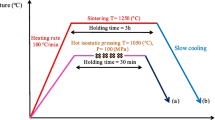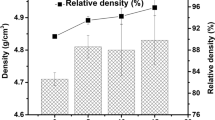Abstract
In this study, an alumina-toughened zirconia composite (ATZ) was developed from mechanical alloyed nano-scale powder mixtures using low-sintering temperatures. A powder mixture, composed of 80 wt.% Y-TZP, ZrO2 (3 mol.% Y2O3), and 20 wt.% Al2O3, was prepared by mechanical alloying (MA) in a planetary ball mill under argon atmosphere, with milling times of up to 60 h, using a rotary speed of 200 rpm and a ball-to-powder weight ratio of 10:1. The mixtures were compacted at 100 MPa and sintered at 1400 °C—2 h. In the milled powders, the crystallite size of the ZrO2 matrix was reduced from 130 to 40 Å, when increasing the milling time from 1 to 60 h. After sintering, the samples were characterized by its phase composition, microstructure, relative density, fracture toughness and biaxial flexural strength. Fully dense samples were obtained after sintering the powder-mixture milled for 60 h at 1400 °C—2 h. In comparison, the conventional powder-mixture achieved high densification only after sintering at 1600 °C—2 h. Sintered samples prepared with mechanical alloyed powder mixtures presented a fracture toughness (KIC) of 8.2 ± 0.3 MPa m1/2 and a bending strength of 880 ± 45 MPa, significantly higher compared to samples prepared from the conventional processed powder mixture sintered at 1600 °C—2 h, presenting a KIC of 6.7 ± 0.5 MPam1/2 and a bending strength of 697 ± 85 MPa. The improved mechanical strength of the composites prepared from mechanical alloyed powders is attributed to the increased sinterability of these powders, allowing full densification at 1400 °C, and also resulting in a reduction in the tetragonal ZrO2 grain size. Thus, a larger population of these grains is formed in the microstructure, increasing fracture toughness and strength by the tetragonal to monoclinic phase transformation toughening mechanism.








Similar content being viewed by others
References
Chevalier J (2006) What future for zirconia as a biomaterial? Biomaterials 27(4):535–543
Piconi C, Maccauro G (1999) Zirconia as a ceramic biomaterial. Biomaterials 20(1):1–25
Stevens R (1986) An introduction to zirconia. Magnesium elektron publication, Manchester, UK
Chevalier J, Gremillard L, Virkar AV, Clarke DR (2009) The tetragonal-monoclinic transformation in zirconia: lessons learned and future trends. J Am Ceram Soc 92(9):1901–1920
Chevalier J, Gremillard L, Deville S (2007) Low-temperature degradation of zirconia and implications for biomedical implants. Annu Rev Mater Res 37:1–32
Siarampi E, Kontonasaki E, Andrikopoulos KS et al (2014) Effect of in vitro aging on the flexural strength and probability to fracture of Y-TZP zirconia ceramics for all-ceramic restorations. Dent Mater 30(12):e306–e316
International Organization for Standardization, ISO 13356:2015: implants for surgery - ceramic materials based on yttria-stabilized tetragonal zirconia (Y-TZP)
Sequeira S, Fernandes MH, Neves N, Almeida MM (2017) Development and characterization of zirconia–alumina composites for orthopedic implants. Ceram Int 43(1):693–703
Kurtz SM, Kocagöz S, Arnholt C, Huet R, Ueno M, Walter WL (2014) Advances in zirconia toughened alumina biomaterials for total joint replacement. J Mech Behav Biomed Mater 31:107–116
Hossen MM, Chowdhury FUZ, Gafur MA, Hakim AA, Hossen MB (2014) Effect of zirconia substitution on structural and mechanical properties of ZTA composites. IOSR J Mech Civil Eng 11(2):01–07
De Aza AH, Chevalier J, Fantozzi G, Schehl M, Torrecillas R (2002) Crack growth resistance of alumina, zirconia and zirconia toughened alumina ceramics for joint prostheses. Biomaterials 23(3):937–945
Basu B, Vleugels J, Van Der Biest O (2004) Transformation behaviour of tetragonal zirconia: role of dopant content and distribution. Mater Sci Eng, A 366(2):338–347
Taya M, Hayashi S, Kobayashi AS, Yoon HS (1990) Toughening of a particulate-reinforced ceramic-matrix composite by thermal residual stress. J Am Ceram Soc 73(5):1382–1391
Suryanarayana C (2001) Mechanical alloying and milling. Prog Mater Sci 46(1–2):1–184
Benjamin JS (1992) Fundamentals of mechanical alloying. Mater Sci Forum 88:1–18
Hüller M, Chernik GG, Fokina EL, Budim NI (2008) Mechanical alloying in planetary mills of high accelerations. Rev Adv Mater Sci 18:366–374
Santos C, Habibe AF, Rodrigues D, Minatti JC, Lins JFC, dos Santos LA (2014) Microstructural characterization of 66% Co-28% Cr-6% Mo dental alloy powder obtained by high-energy ball milling. Mater Sci Forum 802:51–55
Lim PN, Konishi T, Wang Z, Feng J, Thian ES (2018) Enhancing osteoconductivity and biocompatibility of silver-substituted apatite in vivo through silicon co-substitution. Mater Lett 212(1):90–93
Hellenbrandt M (2004) The inorganic crystal structure database (ICSD)—present and future. Crystallogr Rev 10(1):17–22
Kraus W, Nolze G (1996) POWDER CELL–a program for the representation and manipulation of crystal structures and calculation of the resulting X-ray powder patterns. J Appl Crystallogr 29(3):301–303
Degen T, Sadki M, Bron E, König U, Nénert G (2014) The high score suite. Powder Diffr 29(S2):S13–S18
Hill RJ, Howard CJ (1987) Quantitative phase analysis from neutron powder diffraction data using the Rietveld method. J Appl Crystallogr 20(6):467–474
Krimm S, Tobolsky AV (1951) Quantitative X-ray studies of order in amorphous and crystalline polymers. Quantitative X-ray determination of crystallinity in polyethylene. J Polym Sci 7(1):57–76
Sproull WT (1946) X-rays in practice. McGraw-Hill, New York, p 438
Klug HP, Alexander LE (1974) X-ray diffraction procedures; for polycrystalline and amorphous materials. Willey, New York, p 618
International Organization for Standardization, ISO 6872:2015: dentistry - ceramic materials
Santos C, Ribeiro S, Daguano JKMF, Rogero SO, Strecker K, Silva CRM (2007) Development and cytotoxicity evaluation of SiAlONs ceramics. Mater Sci Eng, C 27(1):148–153
Jerebtsov DA, Mikhailov GG, Sverdina SV (2000) Phase diagram of the system: Al2O3–ZrO2. Ceram Int 26(8):821–823
Kwon NH, Kim GH, Song HS, Lee HL (2001) Synthesis and properties of cubic zirconia–alumina composite by mechanical alloying. Mater Sci Eng, A 299(1–2):185–194
Farnè G, Ricciardiello FG, Podda LK, Minichelli D (1999) Innovative milling of ceramic powders: influence on sintering zirconia alloys. J Eur Ceram Soc 19(3):347–353
Shi JL, Li BS, Ruan ML, Yen TS (1995) Processing of nano-Y-TZP/Al2O3 composites. I: Preparation and characterization of nano-Y-TZP/Al2O3 composite powders. J Eur Ceram Soc 15(10):959–965
Basu B, Vleugels J, Van Der Biest O (2004) ZrO2–Al2O3 composites with tailored toughness. J Alloy Compd 372(1–2):278–284
Kibbel B, Heuer AH (1986) Exaggerated grain growth in ZrO2-toughened Al2O3. J Am Ceram Soc 69(3):231–236
Matsui K, Horikoshi H, Ohmichi N, Ohgai M, Yoshida H, Ikuhara Y (2003) Cubic-formation and grain-growth mechanisms in tetragonal zirconia polycrystal. J Am Ceram Soc 86(8):1401–1408
Matsui K, Ioshida H, Ikuhara Y (2008) Grain-boundary structure and microstructure development mechanism in 2–8mol% yttria-stabilized zirconia polycrystals. Acta Mater 56(6):1315–1325
Loudjani MK, Cortès R (2000) Study of the local environment around zirconium ions in polycrystalline α-alumina in relation with kinetics of grain growth and solute drag. J Eur Ceram Soc 20(10):1483–1491
Chevalier J, Deville S, Münch E, Jullian R, Lair F (2004) Critical effect of cubic phase on aging in 3 mol% yttria-stabilized zirconia ceramics for hip replacement prosthesis. Biomaterials 25(24):5539–5545
Heuer AH, Claussen N, Kriven WM, Ruhle M (1982) Stability of tetragonal ZrO2 particles in ceramic matrices. J Am Ceram Soc 65(12):642–650
Dehestani M, Adolfsson E (2012) Phase stability and mechanical properties of zirconia and zirconia composites. Int J Appl Ceram Technol 10(1):129–141
Filippov RA, Freidin AB, Hussainova IV, Vilchevskaya EN (2015) Critical radius of zirconia inclusions in transformation toughening of ceramics. Phys Mesomech 18(1):33–42
Casellas D, Nagl M, Llanes L, Anglada M (2003) Fracture toughness of alumina and ZTA ceramics: microstructural coarsening effects. J Mater Process Technol 143–144:148–152
Maji A, Choubey G (2018) Microstructure and mechanical properties of alumina toughened zirconia (ATZ). Mater Today Proc 5(2):7457–7465
Shi JL, Lu ZL, Guo JK (2000) Model analysis of boundary residual stress and its effect on toughness in thin boundary layered yttria-stabilized tetragonal zirconia polycrystalline ceramics. J Mater Res 15(3):727–732
Shi JL, Li L, Guo JK (1998) Boundary stress and its effect on toughness in thin boundary layered and particulate composites: model analysis and experimental test on Y-TZP-based ceramic composites. J Eur Ceram Soc 18(14):2035–2043
Rühle M, Evans AG (1989) High toughness ceramics and ceramic composites. Prog Mater Sci 33(2):85–167
Hannink RH, Kelly PM, Muddle BC (2000) Transformation toughening in zirconia-containing ceramics. J Am Ceram Soc 83(3):461–487
Amaral M, Lopes MA, Silva RF, Santos JD (2002) Densification route and mechanical properties of Si3N4–bioglass biocomposites. Biomaterials 23(3):857–862
Acknowledgements
The authors would like thank FAPERJ (E26-01.476/2014) and CNPq (311.119/2017-4, 132.136/2018-0) for financial support. Furthermore, this study was financed in part (doctoral support—B. Xavier) by CAPES (Coordenação de Aperfeiçoamento de Pessoal de Nível Superior).
Author information
Authors and Affiliations
Corresponding author
Additional information
Technical Editor: Adriano Almeida Gonçalves Siqueira.
Publisher's Note
Springer Nature remains neutral with regard to jurisdictional claims in published maps and institutional affiliations.
Rights and permissions
About this article
Cite this article
de Freitas, B.X., Alves, M.F.R.P., Santos, C. et al. Mechanical properties of biocompatible Y-TZP/Al2O3 composites obtained from mechanically alloyed powders. J Braz. Soc. Mech. Sci. Eng. 42, 353 (2020). https://doi.org/10.1007/s40430-020-02431-1
Received:
Accepted:
Published:
DOI: https://doi.org/10.1007/s40430-020-02431-1




